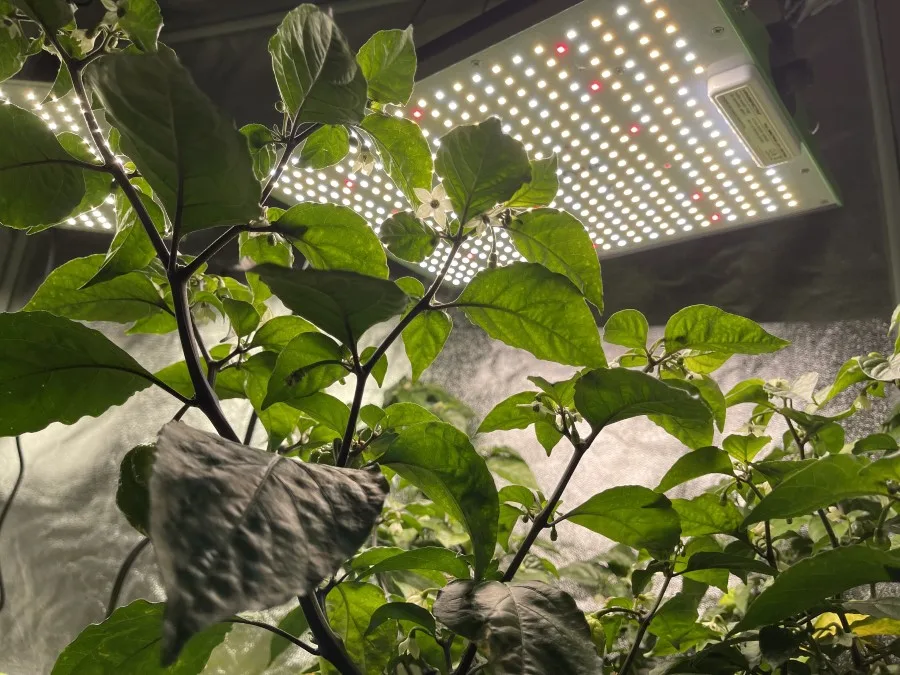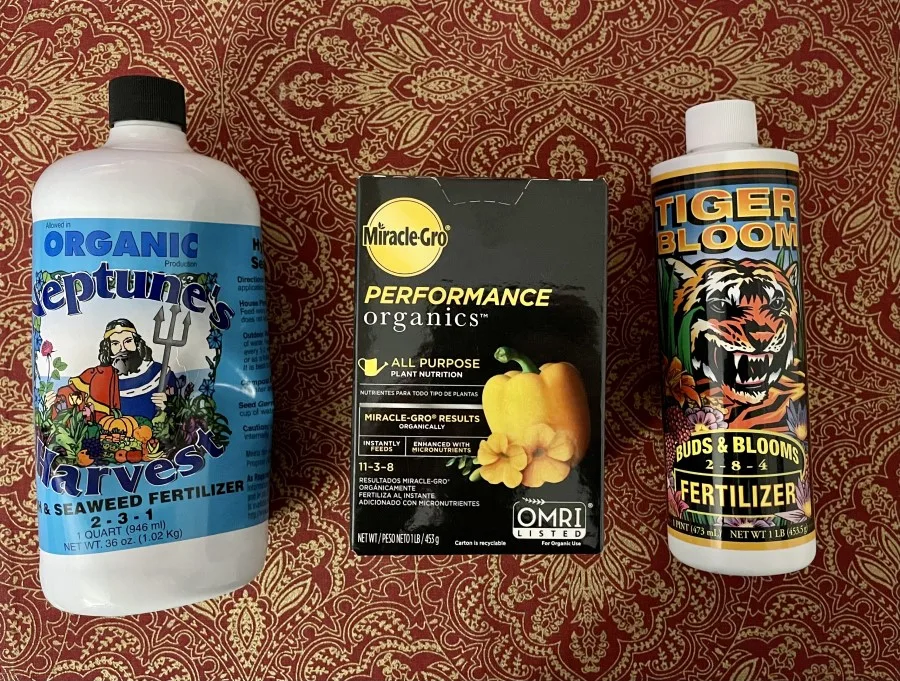Growing Carolina Reaper peppers is relatively simple but can sometimes present challenges. One of the challenges you may face is that the plant begins to lose its flowers before it can produce peppers.
Your Carolina Reaper plant’s flowers can fall off due to improper watering or too high temperatures. The problem could also be caused by poor nutrient levels, a lack of pollination, or low levels of humidity.
We’ll get into each of these reasons and discuss some things you can do to help get your Carolina Reaper plants back to full health and producing peppers. Let’s get started!

1. The Plant Isn’t Being Watered Correctly
Both underwatering and overwatering tend to cause major complications in Carolina Reaper plants.
In our experience, our Carolina Reaper plant began to drop its flowers when we became inconsistent in our watering habits. This was especially clear when we forgot to water the pepper plant for a few days.
To properly water Carolina Reaper peppers, stick your finger an inch down in to the soil. Only water the plant if the soil is dry. For more detailed information on watering pepper plants, check out our post How Often You Should Water a Pepper Plant.
We were watering our Carolina Reaper pepper plants that we were growing in pots every other day. When the plants became full-sized and produced pods, they were drinking water like crazy, almost needing daily watering.
Another thing that is important when it comes to these plants is that they must be watered at fairly consistent intervals. It’s best to water them in the mornings, but it can be done consistently at any time, especially if your plants are growing indoors.
Carolina Reapers can present more problems than just flowers dropping off when you aren’t consistent in your watering habits. The leaves can rapidly change color, the plant can experience root rot, and the plant can stop producing peppers.
The best way to water your Carolina Reaper is to give the plants a consistent amount daily or every other day. This way, the plants will know what to expect. Too much water one day and too little another can cause enormous stress for your Reapers, causing them to drop their flowers.
2. The Reaper Plants Have Been Exposed to Inconsistent Temperatures
Carolina Reaper pepper plants function best at temperatures that don’t exceed 90 degrees Fahrenheit (32 degrees Celsius). These plants prefer moderate temperatures that lean on the tropical side. They do best at temperatures above 65 degrees Fahrenheit (18 degrees Celcius) and less than 85 degrees Fahrenheit (29 degrees Celsius).
The Carolina Reapers are a little more sensitive to heat than cold (except in the case of freezing temperatures), and when exposed to too high of temperatures, you notice a few different things.
You first notice that the Carolina Reaper’s leaves begin to discolor. This is more common when they have been exposed to direct sunlight for too long. While Carolina Reapers need full sun for a good part of the day, too much of a good thing becomes bad.
You’ll also notice that the plant begins wilting as if drowning in the heat. The leaves may fold inward upon themselves.
Finally, you’ll notice that the Carolina Reaper plant begins to drop its flowers.
Dropping flowers can happen on either temperature swing: up or down. The biggest thing Carolina Reapers need is consistency in the temperatures they’re exposed to. In our experience, big ambient temperature swings encouraged the flowers to start dropping. As the temperature swings continued, more and more flowers were lost.
The best thing that you can do is work to minimize temperature swings with your Carolina Reapers. You can either grow them indoors to keep a consistent temperature or place them in another sheltered environment, such as a greenhouse or a grow tent. You can also use grow lights or heating pads to help keep your Carolina Reaper pepper plants warm.

3. The Carolina Reaper Plant Has Poor Nutrient Levels
Carolina Reapers tend to be on the sensitive side when it comes to nutrient levels. Like all pepper plants, they need three primary nutrients: nitrogen, phosphorus, and potassium. However, these need to be balanced in the right way, or the plant will suffer from nutrient deficiencies.
It’s pretty easy for Carolina Reapers to become nutrient deficient, particularly if planted outside in natural soils. This is because soil naturally fluctuates between various pH levels and nutrient levels.
If your Carolina Reapers are dropping flowers, it’s generally due to too little phosphorus combined with too much nitrogen.
Phosphorus helps plants to convert nutrients into smaller blocks which can be used to assist them in growing. It is an essential part of the plant’s growth, and when your Carolina Reapers are deficient in it, you may notice a few things.
If your Carolina Reapers are deficient in phosphorus, you’ll notice that the plants are significantly smaller than they should be. This is because they aren’t able to break down other nutrients that come through their root systems.
In addition, if your Carolina Reapers are deficient in phosphorus, the plants may produce little or no flowers. The flowers that are produced may quickly drop off.
You may also notice discoloration on the plant as a bright green or purplish color. The root systems will also be weaker and discolored.
Nitrogen is key in helping plants to produce chlorophyll, which works to absorb sunlight so that the plant can receive nutrients. While this is absolutely necessary, it can have detrimental consequences when the plant becomes overloaded with nitrogen, particularly while being deficient in phosphorus.
Some things to look out for when it comes to too much nitrogen include the following:
- Extra foliage, but no flowers or fruits: Extra nitrogen encourages the plant to grow tons of leaves, but you won’t notice extra flowers.
- Burned-looking leaves: When the plant has been exposed to excessive nitrogen, it also gets exposed to extra salts. These salts suck the water from the plant, and when the water evaporates, the salt is left behind. In this way, the leaves become dehydrated and take on a burned look.
- Stunted root growth: The energy that gets put towards growing all those extra leaves can heavily stunt the development of the plant’s root system.
4. The Carolina Reaper Isn’t Being Pollinated Correctly
Plant pollination is a mystery for many people. The plants appear to go through some mysterious process and come out with peppers and other fruits. However, pollination takes place in pretty specific ways, and when your Carolina Reaper isn’t pollinating correctly, it can cause problems with the flowers.
For more flowers to be produced and the current ones to eventually turn into fiery Carolina Reaper peppers, pollination must occur. Typically pollination happens through pollen falling from one flower to another.
The wind and other pollinators, such as bees, can also carry pollen from one plant to another.
When the plants aren’t exposed to other Carolina Reapers or when a single plant hasn’t produced enough pollen, it leads to low pollination rates. This, in turn, leads to higher rates of flower drop.
You can encourage natural pollination by shaking the plant lightly, placing them in a windy area, or bringing in other pollinators such as bees or butterflies.
You can also hand pollinate if necessary. Our Carolina Reapers didn’t produce a lot of pollen compared to our less spicy peppers. We encouraged pollination by gently brushing along the Carolina Reaper flowers to collect and spread the small amounts of pollen to each flower.
5. The Humidity Level is Too Low
Humidity plays into how a plant grows in more ways than you may initially think. Carolina Reapers prefer moderate to slightly higher humidity levels. The maximum humidity level you want to maintain for Carolina Reapers is about 70%.
When humidity levels aren’t in the right window for your Carolina Reaper plant, its flowers won’t release pollen, and the few flowers the plant has will drop off. This is more common with low humidity since Reapers prefer conditions with higher humidity.
If you’re growing Carolina Reapers indoors, you can use a humidifier to increase the room’s humidity level. You can find specific humidifiers for plants, the VIVOSUN small space humidifier is our favorite.
